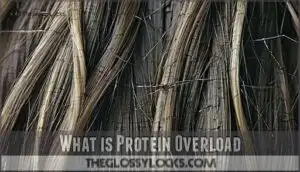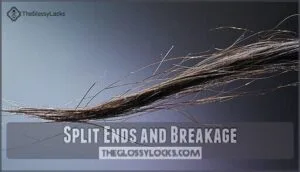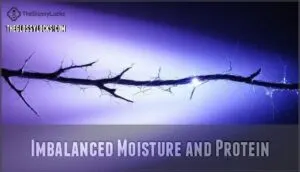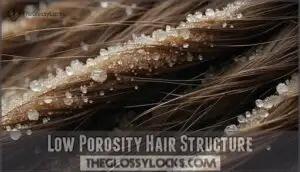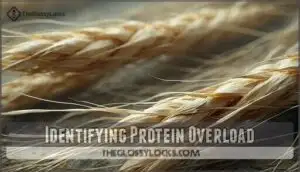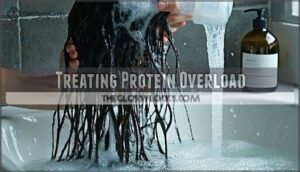This site is supported by our readers. We may earn a commission, at no cost to you, if you purchase through links.
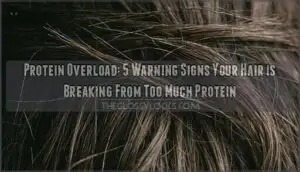
It’s often caused by overusing protein-packed products, like keratin treatments, or by not balancing protein with moisture.
If your hair feels stiff, straw-like, or snaps easily, it might be suffering from this imbalance.
Low-porosity hair is especially prone to protein buildup since it’s less efficient at absorbing moisture.
The good news? Balancing protein with hydration can work wonders.
Moisturizing masks, clarifying shampoos, and avoiding heavy protein products can help restore your hair’s elasticity and shine.
Curious about what to avoid next?
Table Of Contents
- Key Takeaways
- What is Protein Overload
- Signs of Protein Overload
- Causes of Protein Buildup
- Identifying Protein Overload
- Treating Protein Overload
- Preventing Protein Overload
- Frequently Asked Questions (FAQs)
- How do you fix protein overload?
- What are the symptoms of too much protein in the body?
- What happens when you have too high protein?
- Can diet affect protein overload in hair?
- How does hair porosity influence protein sensitivity?
- Are there specific hair types more prone to protein overload?
- Can environmental factors contribute to protein overload?
- How long does it take to recover?
- Can protein overload affect hair growth?
- Are specific hair types more susceptible?
- Conclusion
Key Takeaways
- Don’t overuse protein-packed products or layer multiple protein treatments—it disrupts your hair’s moisture balance and leads to dryness, brittleness, and breakage.
- If your hair feels stiff, straw-like, or snaps easily, you might be dealing with protein overload; low porosity hair is especially vulnerable.
- Fix protein overload by using a clarifying shampoo to remove buildup, then deeply hydrate with masks or conditioners.
- Keep protein and moisture balanced in your routine, tailoring products to your hair type and porosity to maintain healthy strands.
What is Protein Overload
Your hair’s experiencing protein overload when excess protein builds up on the outer layer of your strands, resulting in a brittle, dry texture prone to breakage.
You’ll notice this imbalance occurs when you’ve used too many protein-rich hair products, disrupting the natural moisture balance that keeps your hair strong and flexible.
Definition of Protein Overload
Struggling with brittle hair that snaps like twigs? You’re likely experiencing protein overload—a condition where excess protein builds up in your hair’s cortex, disrupting the natural moisture balance.
This keratin buildup occurs when too many protein-rich hair products coat your strands, creating an imbalance between protein and moisture.
Unlike regular damage, protein excess makes your hair stiff and unmanageable, particularly affecting those with low porosity hair.
Causes of Protein Overload
Now that you understand what protein overload is, let’s examine why it happens.
Your hair can develop protein buildup when you use too many protein-rich products simultaneously.
This protein layering effect disrupts your hair’s natural moisture-protein balance.
Low porosity hair is particularly susceptible since it struggles to absorb products properly.
Keratin treatment misuse and excessive protein treatments can also contribute to hair protein overload, especially when not balanced with adequate moisture.
Effects on Hair Quality
When too much protein builds up on your hair, the consequences aren’t pretty.
Excess protein leaves your hair stiff, brittle, and lifeless, stealing its natural shine and elasticity.
Your once-soft locks become straw-like, with hair texture turning rough and brittle.
Strand strength decreases dramatically, leading to hair breakage at the slightest touch.
You’ll notice significant elasticity impact—your hair won’t "bounce back" when stretched.
Hair protein overload symptoms also include shine reduction and manageability issues that make styling nearly impossible.
Signs of Protein Overload
You’ll notice several warning signs when your hair has too much protein buildup, including brittleness, dryness, and a straw-like texture that snaps easily when stretched.
Your once-healthy locks may also lose their natural elasticity and shine, with increased breakage and split ends signaling it’s time to adjust your hair care routine to address the issue of protein buildup.
Dryness and Brittleness
Now that you understand what protein overload is, let’s look at its most obvious sign: dryness and brittleness. When your hair has too much protein buildup, it becomes noticeably parched and stiff to the touch.
Hair porosity plays a key role here, as low porosity strands can’t absorb needed hydration when coated with excess protein.
- Your hair feels like straw – rough, coarse, and lacking moisture
- Products that normally work well suddenly leave your hair feeling drier
- Your strands snap easily rather than stretch when pulled gently
Split Ends and Breakage
Beyond the dryness, you’ll notice split ends multiplying faster than usual when protein overload occurs.
Your hair doesn’t just break—it snaps cleanly rather than stretching first. This happens because excess protein makes hair fibers rigid and unable to bend.
The severity of breakage often increases with styling, as protein-overloaded hair can’t withstand even minimal manipulation. Hair damage from protein buildup requires specific repair strategies targeting moisture balance.
Protein overload leads to a condition where hair is extremely fragile, and the problem is exacerbated by the fact that protein-overloaded hair can’t withstand styling.
Loss of Elasticity and Shine
Looking closely at your hair, you’ll notice two key indicators of protein overload: significant loss of elasticity and diminished shine.
When healthy hair stretches slightly before returning to its natural state, but protein-overloaded strands snap instantly when pulled.
Your once-vibrant locks now appear dull and lifeless, due to stiffness and dullness that occur because excess protein prevents natural moisture balance, leaving hair brittle and lacking its natural luster.
To combat this, consider using protein free conditioners to help restore balance.
Causes of Protein Buildup
You’re likely overloading your hair with protein when you use multiple protein-rich products like shampoos, conditioners, and styling treatments at once.
This excessive use disrupts your hair’s natural moisture balance, creating a barrier that prevents proper hydration and leaves your strands feeling dry and brittle.
Imbalanced Moisture and Protein
The delicate dance between protein and moisture in your hair can easily fall out of step.
When you overuse protein treatments without balancing them with hydrating products, you’re setting yourself up for protein overload.
Your hair’s natural protein-moisture balance gets disrupted, leading to brittleness instead of strength.
Remember, even the best protein-rich formulations can damage your hair if they’re not countered with proper moisture retention strategies.
Low Porosity Hair Structure
Your hair’s porosity level substantially impacts how it handles protein treatments.
Low porosity hair has tightly bound cuticles that resist product absorption, creating the perfect storm for protein overload.
When you apply protein-rich treatments to low porosity hair, they often sit on the surface rather than penetrating properly.
This buildup blocks moisture retention and leads to dryness and brittleness.
Understanding your hair’s porosity helps prevent unwanted protein sensitivity and excessive buildup.
To combat this, consider using products designed to enhance curl definition.
Identifying Protein Overload
You can spot protein overload by paying attention to changes in your hair’s texture, like increased stiffness or a straw-like feel.
Understanding these signs helps you distinguish it from other types of damage, ensuring you address the root cause effectively, and this is crucial for applying the right treatment to fix the protein overload.
Hair Texture and Appearance
Your hair’s texture can reveal protein overload.
Watch for these signs:
- Hair stiffness—strands feel rigid, not pliable.
- Hair dullness—lost sheen or color vibrancy.
- Curl definition fades, with limp or uneven waves.
- Volume control issues—hair appears flat or lifeless.
These changes indicate disrupted balance, signaling potential hair protein overload or damage.
Moisture Balance and Protein Levels
Striking the right moisture balance is key to avoiding protein overload. Too much protein disrupts hydration, leaving hair dry and brittle.
Low porosity hair struggles with protein absorption, intensifying buildup. Overlapping protein-rich products? That’s a recipe for trouble.
Regular routine adjustments help maintain healthy protein levels. One sign of this imbalance can be flatter than normal roots.
| Factor | Impact on Hair | Solution | Risk of Overload |
|---|---|---|---|
| Hydration Importance | Prevents dryness | Use moisturizing masks | Low |
| Protein Absorption | Affects buildup | Limit protein treatments | High |
| Porosity Impact | Impacts moisture intake | Tailor products to type | Moderate |
| Product Layering | Increases buildup risk | Avoid overlapping products | High |
Distinguishing From Other Hair Damage
To spot protein overload versus other hair damage, focus on texture and cause.
Protein overload stiffens hair, unlike heat damage, which leaves frizz, or chemical damage, which weakens strands.
Here’s how to tell:
- Heat Damage: Frizz, dullness, split ends.
- Chemical Damage: Weak, stretchy strands.
- Environmental Factors: Dryness from weather.
- Porosity Differences: Low porosity traps protein.
- Damage Overlap: Investigate product use.
Treating Protein Overload
To fix protein overload, you’ll need to focus on removing the excess buildup and restoring moisture.
Using a clarifying shampoo followed by hydrating treatments can help rebalance your hair and improve its texture.
Clarifying Shampoos and Detox
If your hair feels heavy or breaks easily, it’s time to rethink your routine.
Clarifying shampoos tackle hair product buildup effectively, making excess protein removal simple.
Explore a clarifying shampoo detox for a deeper cleanse.
Use chelating shampoos monthly for scalp health without dryness.
For a DIY detox, warm water prep enhances results.
Compare options below:
| Product Type | Removes Excess Protein | Ideal Frequency | Best For | Extras |
|---|---|---|---|---|
| Clarifying Shampoo | Yes | Monthly | All Hair Types | Detoxifies Gently |
| Chelating Shampoo | Yes | Monthly | Low Porosity Hair | Retains Natural Oils |
| DIY Detox | Partially | Occasionally | Sensitive Scalps | Budget-Friendly |
| pH-Optimized | Yes | Bi-Monthly | Moderately Damaged | Non-Stripping |
| Warm Water Soak | No, Pre-treatment | Before Washing | Protein-Overloaded | Boosts Cleansing |
Moisturizing Treatments and Masks
After clarifying shampoos, hydration is your next move.
Moisturizing treatments like hair masks and deep conditioners restore balance, softness, and elasticity.
Consider using specialized hydration products for enhanced results.
Try these steps:
- Use a hair mask weekly with hydration-boosting ingredients like honey or coconut oil.
- Apply DIY masks for natural nourishment.
- Focus on proper application techniques for even coverage.
- Adjust hydration frequency based on hair needs.
- Embrace mask benefits for lasting hair care.
Preventing Protein Overload
To prevent protein overload, you need to focus on balancing protein and moisture in your haircare routine.
By customizing your product choices and regularly evaluating your hair’s needs, you can maintain healthy, resilient strands.
Balancing Protein and Moisture
Balancing protein and moisture is key to healthy hair.
Focus on hydration importance by using moisture replenishment treatments like deep conditioners to offset protein sensitivity.
Avoid product layering with multiple protein-rich products, as it disrupts the protein-moisture balance.
Consider your hair’s porosity balance to adjust care routines. This guarantees hair protein overload doesn’t leave strands brittle and lifeless.
Customizing Haircare Routines
Every hair care routine thrives on balance.
Consider your hair porosity and avoid excessive product layering. Adjust your routine seasonally to match humidity or dryness, and factor in your lifestyle and scalp health.
Limit hair protein treatment frequency to maintain a healthy protein-moisture balance. Regularly tweak your hair product balance to prevent overload and keep your strands thriving.
A good start is to understand natural hair types for better product selection.
Regular Hair Assessments and Adjustments
Keeping your hair healthy means keeping an eye on how it responds to products and changes in your routine.
Regular assessments help you spot issues early.
- Monitor scalp health for dryness or buildup.
- Adjust for seasonal changes affecting moisture needs.
- Note product sensitivity with new items.
- Consider lifestyle factors like stress.
- Seek professional consultations for hair protein overload solutions.
Frequently Asked Questions (FAQs)
How do you fix protein overload?
When your hair feels like straw, strip excess protein with a clarifying shampoo.
Restore its balance by hydrating with moisture-rich masks or leave-in conditioners.
Avoid layering protein products, and focus on gentle, sulfate-free care.
What are the symptoms of too much protein in the body?
If your body’s overloaded with protein, you might feel dehydrated, deal with bad breath, or even experience issues like constipation.
Over time, too much protein strains your kidneys and may trigger headaches or irritability.
What happens when you have too high protein?
You’re not turning into a gym protein shake, but consuming too much protein can strain your kidneys, cause dehydration, and create issues like nausea or constipation.
Balance is key—your body needs variety, not just protein.
Can diet affect protein overload in hair?
Your diet doesn’t directly cause protein overload in hair.
It’s all about the hair products you use.
Eating too much protein won’t affect your strands, but overusing protein-rich treatments definitely can—so balance is key!
How does hair porosity influence protein sensitivity?
Porosity works like your hair’s gatekeeper—low porosity hair repels moisture and protein, making it prone to buildup.
While high porosity absorbs too much, risking overload.
Balance hydration and protein for the perfect harmony.
Are there specific hair types more prone to protein overload?
Curly, coarse, and low-porosity hair types are more prone to protein overload since they struggle to retain moisture.
If your hair feels stiff or brittle after protein treatments, it’s likely time to rebalance with moisture-rich products.
Can environmental factors contribute to protein overload?
It’s surprising, but environmental factors like hard water, chlorine, or air pollution don’t directly cause protein overload.
However, they can weaken hair, making it more vulnerable to damage if you’re overusing protein-rich products.
How long does it take to recover?
Recovery time varies but typically takes a few weeks to several months.
Focus on clarifying shampoos, deep hydration, and skipping protein-heavy products.
Consistency is key, and your patience will help restore your hair’s balance.
Can protein overload affect hair growth?
Yes, protein overload can slow hair growth indirectly.
Excess protein weakens strands, leading to breakage and reduced hair length over time.
Restoring moisture balance and avoiding overuse of protein products can help prevent this.
Are specific hair types more susceptible?
Ever wonder why some hair types seem to struggle with certain products?
Low porosity hair is more prone to issues because it resists absorbing moisture, allowing protein to build up, causing dryness and brittleness.
Conclusion
It’s ironic how something meant to strengthen your hair, like protein, can leave it dry and brittle when overdone.
Protein overload is all about balance—too much tips the scales and harms your strands.
By recognizing the warning signs, like breakage and stiffness, and swapping heavy protein products for hydration-focused care, you can restore elasticity and shine.
Regularly assess your hair’s needs, tweak your routine, and remember: moisture is just as essential as protein for healthy, resilient hair.

